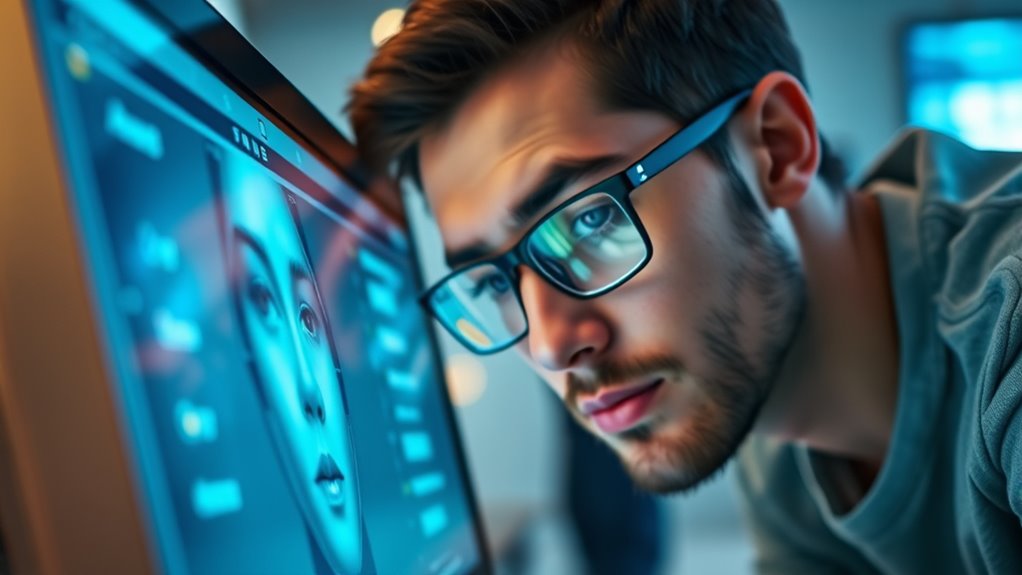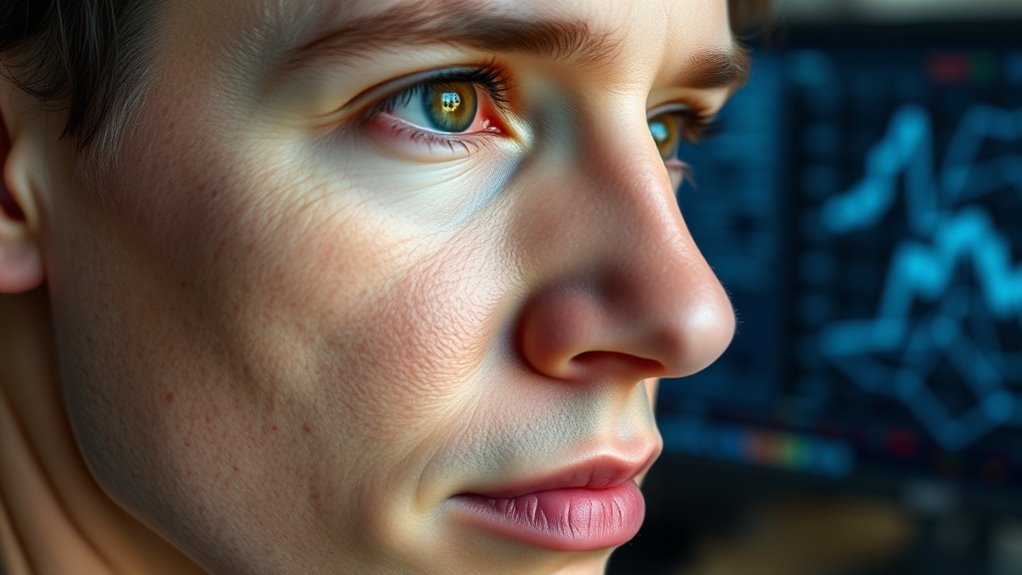To spot a deepfake, look for unnatural facial movements like irregular blinking or mismatched expressions. Check if lighting and shadows on the face align with the environment, and watch for blurry edges or artifacts around the face and hairline. Pay attention to audio syncing—if speech doesn’t match lip movements or sounds off, it’s suspicious. Observing these clues can help you identify fakes; explore further for more detailed tips.
Key Takeaways
- Examine facial movements for unnatural blinking, exaggerated expressions, or lip-sync issues that don’t match speech.
- Check lighting and shadows on the face for inconsistencies with the scene’s environment.
- Look for irregular edges, blurry artifacts, or glitches around facial boundaries and hairline.
- Listen closely to audio and observe lip movements to ensure they align with spoken words.
- Verify the video’s source and research for signs of manipulation or prior debunking.

Deepfakes are rapidly becoming more sophisticated, making it harder to tell real from fake. These advanced forms of synthetic media often use facial manipulation techniques to create videos that look incredibly authentic. As technology evolves, so does the challenge of spotting fake videos, but understanding some basic cues can help you stay one step ahead. When examining videos, pay close attention to facial movements. Deepfake creators often struggle with perfect facial manipulation, so look for unnatural blinking patterns or mismatched facial expressions that don’t quite sync with the audio or context. If someone’s eyes seem too wide or their blinking is irregular, it could be a sign of a synthetic media deepfake. Another telltale sign is inconsistent lighting or shadows on the face, which can result from the digital manipulation process. If the lighting doesn’t match the surroundings or appears off, it’s worth questioning the video’s authenticity.
Pay attention to the edges of the face and hair. Deepfake creators sometimes leave telltale artifacts—fuzzy or blurry borders around the face—because they struggle with seamless blending during facial manipulation. If you notice that the edges of a person’s face or hair look unnaturally sharp or blurry, it might be a sign of a fake. Also, listen carefully to the audio. Deepfake videos often have mismatched lip movements or voice inconsistencies that don’t align perfectly with what the person is saying. If the speech sounds unnatural or the mouth doesn’t move in sync with the audio, it’s a red flag.
Another effective step is to verify the source of the video. Trusted outlets or official channels are less likely to share fake content. If a video seems suspicious, do some quick research to see if it’s been flagged or debunked by fact-checkers. Check for any signs of editing or manipulation by zooming in or pausing at critical moments. Many deepfakes contain subtle glitches or irregularities that become more apparent with close inspection. Recognizing the role of high-quality projectors and their impact on visual clarity can also help in assessing video authenticity, especially when viewing on large screens.
Finally, trust your instincts. If something feels off—whether it’s facial expressions, voice mismatches, or the context of the video—take a moment to verify before sharing or reacting. With practice, you’ll become more adept at spotting these signs, helping you avoid falling victim to misleading synthetic media. As deepfake technology gets better, staying vigilant and applying these simple steps will be your best defense against deception.
Frequently Asked Questions
Can Deepfakes Be Used for Positive Purposes?
Yes, deepfakes can be used for positive purposes. You might see them in ethical uses like enhancing entertainment, creating realistic visual effects, or reconstructing historical figures for educational content. They can help bring stories to life or assist in training simulations. When used responsibly, deepfakes offer innovative ways to entertain and educate, but always with caution to avoid misuse or misinformation.
How Can AI Improve Deepfake Detection Accuracy?
AI acts like a vigilant guard at the gate, constantly learning to spot fakes. It can improve deepfake detection accuracy by refining neural networks with data augmentation, exposing the system to diverse, realistic scenarios. This approach helps AI recognize subtle inconsistencies and artifacts, making it harder for deepfakes to slip through undetected. Your proactive use of these techniques keeps the digital space safer and more trustworthy.
Are There Legal Consequences for Creating Deepfakes?
You should know that creating deepfakes can have serious legal repercussions, especially if they involve defamation, harassment, or violate privacy rights. Authorities are increasingly cracking down on unethical uses of deepfake technology due to ethical concerns and potential harm. If you produce or distribute malicious deepfakes, you could face fines, lawsuits, or even criminal charges, so it’s essential to understand the legal boundaries and ethical implications involved.
How Often Are Deepfakes Used in Misinformation Campaigns?
You might wonder how often deepfakes fuel misinformation campaigns. They’re increasingly used in media manipulation and political propaganda, making it harder to trust what you see online. While exact numbers vary, experts agree that their use is rising, especially in attempts to sway public opinion or discredit individuals. Being aware of this trend helps you stay vigilant and question suspicious videos, protecting yourself from falling victim to false narratives.
What Tools Are Available for the Public to Verify Videos?
Think of fake videos as wolves in sheep’s clothing—you need sharp tools to spot them. You can use free video authentication tools like InVID or Amber Video, which analyze videos for signs of manipulation. These fake video detection tools help verify authenticity by checking metadata or inconsistencies. Always stay cautious, and remember, these tools are your digital watchdogs, keeping you safe from deceptive content online.
Conclusion
Just like Sherlock Holmes unravels mysteries, you can spot deepfakes with a keen eye. By paying attention to blinking patterns, unnatural movements, or inconsistent backgrounds, you hold the power to uncover fakes lurking online. Remember, in a world where appearances deceive, your vigilance is your greatest tool—think of yourself as a digital detective, ready to expose the truth behind every video. Stay alert, stay curious, and never take what you see at face value.










